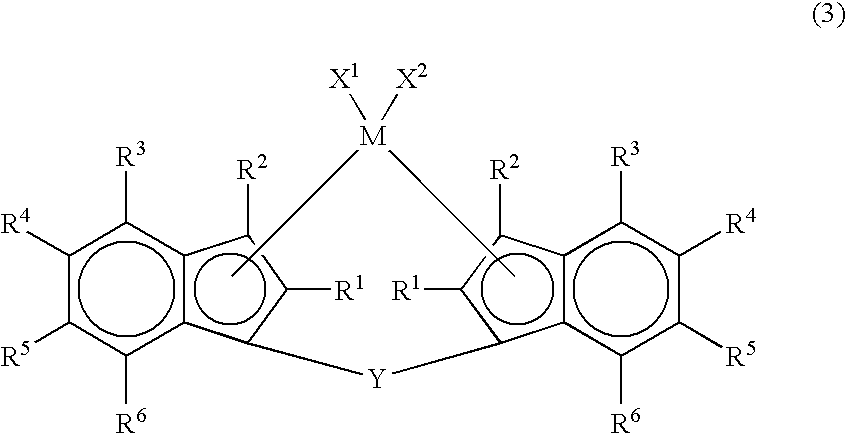Binder resin solution composition, coatings, inks, adhesives and primers
a technology of binder resin and solution composition, which is applied in the direction of adhesive types, coatings, inks, etc., can solve the problems of limiting the handling properties of resin products, difficult to coat or bond resin products, and significant deterioration in coating workability, so as to achieve excellent solvent resistance, excellent adhesion to polyolefin products, and the effect of not impairing the low-temperature flowability and workability of weakly chlorinated polyolefin
- Summary
- Abstract
- Description
- Claims
- Application Information
AI Technical Summary
Benefits of technology
Problems solved by technology
Method used
Image
Examples
example 1
[0079]Polymerization was carried out over 30 minutes by introducing 900 ml of hexane into a 2-liter autoclave sufficiently charged with nitrogen, adding thereto 1 mmol of triisobutylaluminum, heating to 70° C., supplying propylene and ethylene to adjust the total pressure to 0.71 MPa, adding 0.30 mmol of methylaluminoxane and 0.001 mmol (calculated as a Zr atom) of rac-dimethylsilylene-bis[1-(2-methyl-4-phenylindenyl)]zirconium dichloride, and continuously supplying propylene and ethylene to maintain 0.71 MPa total pressure. After polymerization and deaeration, an isotactic propylene-ethylene random copolymer was recovered in an excess of methanol, and dried under reduced pressure for 12 hours at 110° C.
[0080]The isotactic propylene-ethylene random copolymer thus obtained (hereinafter referred to as PE-1) exhibited a melt flow rate of 10 g / 10 min (ASTM 1238: 230° C., 2.16 kg load), ethylene content of 4.0 mol % (2.7 wt. %), Mw / Mn of 2.6, and Tm of 131° C.
[0081]PE-1 (280 g) and chlor...
example 2
[0082]In a similar manner to the first part of Example 1, an isotactic propylene-ethylene random copolymer (hereinafter referred to as PE-2) was produced that exhibited a melt flow rate of 3 g / 10 min (ASTM 1238: 230° C., 2.16 kg load), ethylene content of 6.2 mol % (4.2 wt. %), Mw / Mn of 2.0, and Tm of 117° C.
[0083]PE-2 was chlorinated as in the latter half of Example 1 to obtain toluene solutions of chlorinated polyolefin having a chlorine content of 15 wt. %, 20 wt. %, and 25 wt. %, respectively, and a solid content of 20 wt. % each.
example 3
[0087]Graft polymerization was conducted over 5 hours by introducing 280 g of PE-1, 16.8 g of maleic anhydride, 5.6 g of di-tert-butyl peroxide and 420 g of toluene into an autoclave equipped with a stirrer, charging with nitrogen for about 5 minutes, and heating and stirring at 140° C. After the reaction, the reaction solution was introduced into an excess of methyl ethyl ketone to precipitate the resin. The resin thus obtained was further washed with methyl ethyl ketone several times to remove unreacted maleic anhydride. After drying under reduced pressure, the thus-obtained maleic anhydride-modified polyolefin was chlorinated as in Example 1 to obtain toluene solutions of maleic anhydride-modified chlorinated polyolefin having a chlorine content of 10 wt. %, 15 wt. %, 20 wt. %, and 25 wt. %, respectively, and a solid content of 20 wt. % each.
PUM
| Property | Measurement | Unit |
|---|---|---|
| Temperature | aaaaa | aaaaa |
| Fraction | aaaaa | aaaaa |
| Fraction | aaaaa | aaaaa |
Abstract
Description
Claims
Application Information
 Login to View More
Login to View More - R&D
- Intellectual Property
- Life Sciences
- Materials
- Tech Scout
- Unparalleled Data Quality
- Higher Quality Content
- 60% Fewer Hallucinations
Browse by: Latest US Patents, China's latest patents, Technical Efficacy Thesaurus, Application Domain, Technology Topic, Popular Technical Reports.
© 2025 PatSnap. All rights reserved.Legal|Privacy policy|Modern Slavery Act Transparency Statement|Sitemap|About US| Contact US: help@patsnap.com

